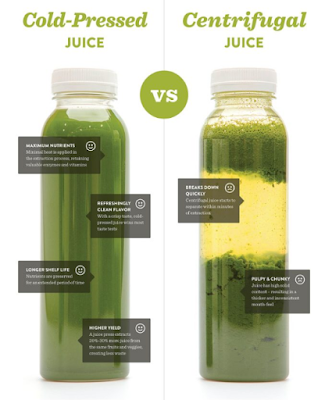Cold Pressed Vs. Centrifugal Juice
Making juice from raw fruits and vegetables is one of the most widely used methods of consuming their vitamins, minerals and enzymes in the purest form. We have been consuming fresh fruit and vegetable juice from decades, but a revolution marked by the introduction of cold-pressed juice has arrived in the juicing industry.
Today, a big question for health-conscious people is what the difference between cold-pressed and centrifugal juice is. The main difference between both lies in the method that is used to extract them, which results in a lot of variation in the quality of the final product.
Let’s first discuss both these techniques to understand why there is a difference to begin with.
Cold Pressed vs. Centrifugal Juicing
Cold-Pressed Juicing
The cold-pressed juicing technique can be divided into two stages:
1. The first stage involves the breakdown of natural raw fruit into a pulp with the use of a rotating steel plate that works gently on fruits and vegetables. This slow process converts the fruit into a pulp without any heat.
2. The second stage involves pressing the pulp between two hydraulic plates to extract the maximum amount of pure juice extract from a fruit.
The fresh juice gets collected into a collection tray, leaving behind the fiber that is completely dry and devoid of any natural vitamins or minerals.
Centrifugal Juicing
The juicing machines we have been using for years that are noisy and prepare the juice within minutes are centrifugal juicing machines. The juicing process goes something like this:
- The whole natural fruit or vegetable goes into the juicing machine.
- The rotating sharp, metal blades in the juicing machine cut the whole fruit into a pulp, spinning out the juice from a filtered bag within minutes.
- The speed of rotation of the blades remains high so that there is no need to cut the fruits in advance, and it instantly transforms fruits into juice, generating a lot of heat and noise.
- The fruit juice gets collected into a collection bag.
How Different Techniques Create All the Difference
The importance of difference in technique can be understood from the fact that live enzymes, nutrients, minerals and vitamins of fruits are so delicate that they can be damaged extensively from even minor exposure to heat. The centrifugal process does exactly the same; it exposes the juice to extreme heat, damaging most of the nutrients and healthy enzymes. On the other hand, cold-pressed juicing is the total opposite. It’s gentle on fruits and vegetables and maintains a cold-temperature, further helping keep the health value and nutrients of the juice.
So, how much difference is there between the qualities of juice produced by these techniques?
Difference in Quality Between Cold-Pressed and Centrifugal Juice
There is actually a big difference between the qualities of centrifugal and cold-pressed juice, and it can be seen the moment you first see them:
- There is a complete difference in their appearance, taste and nutrition value.
- Cold-pressed juice appears darker and tastes more fresh and crisp.
- Cold pressed juice is so fine that it doesn’t separate the fiber and maintains a uniform consistency.
- Cold-pressed juicing can perfectly take out the extract of green, leafy vegetables in their purest and highest form of nutrition value.
- The milk of nuts such as almonds and cashews can also be easily taken out with the cold-press juicing technique, which is not possible with centrifugal juicing.
- Fresh cold pressed juice is 5 times more nutritious than fresh juice taken with the centrifugal technique.
- Cold-pressed juice has a longer shelf-life than centrifugal juices, and they don’t change color within hours.
- Unlike other juices, the use of vegetables is an important part of the cold-pressed juicing technique and increases the variety of nutrients cold-pressed juice can offer.
- The nutritional tests of a Korean food research institute revealed that cold-pressed juicing extracts up to 42% more vitamin C, 60% more vitamin A, and 35-50% more juice than centrifugal juicing.




looking fresh tasty orange make our day fresh and active
ReplyDeletethank you for sharing .
juice recipes
cold press juice machineuses friction and continuous pressure from the screw drives to move and compress the seed material.
ReplyDeleteNaturally extracted juice of cane heated at high temperatures and solidfies to form and crushed into powder form or made into round form asjaggery powder.Organic marachekku oil in bangalore are produced in remarkable diversity by plants, animals, and other organisms through natural metabolic processes. Lipid is the scientific term for the fatty acids, steroids and similar chemicals.Good ennai chekku in chennai has a strong smell when it is opened. The color should be bright brown or gold.
ReplyDeleteThis type of chekku ennai in chennai pressed in room temperature will not be heated during the extraction process and thus retains the nutrition benefits & original taste / flavour.coconut oil doesn’t turn into fat. This is becausecoconut oil cold pressed contains medium-chain triglycerides (MCT), a body fuel that’s easy to burn without transforming to fat.“It is also rich in antioxidants, which boosts immunity.mara check oil also retains lauric acid, which has plenty of therapeutic benefits.”
ReplyDeleteGreat blog. All posts have something to learn. Your work is very good and i appreciate you and hopping for some more informative posts. Best juice cleanse atlanta
ReplyDeleteThank you for your articles that you have shared with us. Hopefully you can give the article a good benefit to us. Everra
ReplyDelete